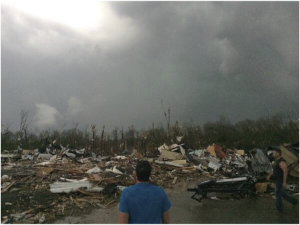IntroductionThis page describes two studies of convection with different characteristics; one over N. America associated with the formation of severe tornadoes, the other over central Africa. The N.America case has strong large scale forcing whereas the central African case is driven by the diurnal cycle. The role of convection in these cases is quite different. Both cases use a forecast from the same date/time (initial conditions). In these case studies, you will carry out a control forecast, followed by any number of suggested sensitivity experiments. | Info |
|---|
These case studies cases were used in the 2014 OpenIFS user workshop at the University of Stockholm.
A Linux 'virtual machine' with a complete copy of the Stockholm workshop exercises is available on request from openifs-support@ecmwf.int.
For more details and copies of handouts, please see the workshop page. |
US Tornado convection case (Arkansas) On the 27 April 7pm local time (00UTC 28 April), tornadoes hit towns north and west of Little Rock, Arkansas killing approx 17 people (see http://edition.cnn.com/2014/04/28/us/severe-weather/index.html?hpt=hp_c2). On the evening on the 28 April fatal tornadoes occurred over Mississippi ( see: http://www.bbc.co.uk/news/world-us-canada-27199071). This case study will look at the role of convection and the large scale in these events.
More information can also be found on the ECMWF Severe Event Catalogue 201404 - Convection - Arkansas U.S.
| Panel |
|---|
| borderColor | white |
|---|
| bgColor | white |
|---|
| titleBGColor | white |
|---|
|   |
African diurnal deep convection (Central Africa)Over tropical land masses, incoming radiation strongly heats the surface leading to the development of deep convection and precipitation. Observations show that convective activity and precipitation peak in the late afternoon or early evening. Until very recently, numerical weather prediction models struggled to reproduce this diurnal cycle, often predicting convection convective activity to peak too early in the day. In this case study, aspects of the convective parameterization scheme can be altered to see how the intensity and the diurnal cycle of convection responds. |